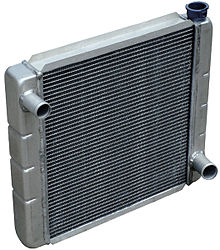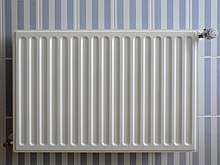Radiator
This article needs additional citations for verification. (March 2009) |

A radiator is a heat exchanger used to transfer thermal energy from one medium to another for the purpose of cooling and heating. The majority of radiators are constructed to function in cars, buildings, and electronics.
A radiator is always a source of heat to its environment, although this may be for either the purpose of heating an environment, or for cooling the fluid or coolant supplied to it, as for automotive engine cooling and HVAC dry cooling towers. Despite the name, most radiators transfer the bulk of their heat via convection instead of thermal radiation.[citation needed]
History
The Roman
Radiation and convection

To increase the surface area available for heat exchange with the surroundings, a radiator will have multiple fins, in contact with the tube carrying liquid pumped through the radiator. Air (or other exterior fluid) in contact with the fins carries off heat. If air flow is obstructed by dirt or damage to the fins, that portion of the radiator is ineffective at heat transfer.
Heating

Radiators are commonly used to heat buildings on the European continent. In a radiative
In some countries, portable radiators are common to heat a single room, as a safer alternative to space heater and fan heater.
Heating, ventilation, and air conditioning
Radiators are used in dry cooling towers and closed-loop cooling towers for cooling buildings using liquid-cooled chillers for heating, ventilation, and air conditioning (HVAC) while keeping the chiller coolant isolated from the surroundings.
Engine cooling


Radiators are used for cooling
To cool down the heat engine, a coolant is passed through the engine block, where it absorbs heat from the engine. The hot coolant is then fed into the inlet tank of the radiator (located either on the top of the radiator, or along one side), from which it is distributed across the radiator core through tubes to another tank on the opposite end of the radiator. As the coolant passes through the radiator tubes on its way to the opposite tank, it transfers much of its heat to the tubes which, in turn, transfer the heat to the fins that are lodged between each row of tubes. The fins then release the heat to the ambient air. Fins are used to greatly increase the contact surface of the tubes to the air, thus increasing the exchange efficiency. The cooled liquid is fed back to the engine, and the cycle repeats. Normally, the radiator does not reduce the temperature of the coolant back to ambient air temperature, but it is still sufficiently cooled to keep the engine from overheating.
This coolant is usually water-based, with the addition of
Up to the 1980s, radiator cores were often made of copper (for fins) and brass (for tubes, headers, and side-plates, while tanks could also be made of brass or of plastic, often a polyamide). Starting in the 1970s, use of aluminium increased, eventually taking over the vast majority of vehicular radiator applications. The main inducements for aluminium are reduced weight and cost.[citation needed]
Since air has a lower
Electronics and computers

As electronic devices become smaller, the problem of dispersing waste heat becomes more difficult. Tiny radiators known as heat sinks are used to convey heat from the electronic components into a cooling air stream. Heatsinks do not use water, rather they conduct the heat from the source. High-performance heat sinks have copper to conduct better. Heat is transferred to the air by conduction and convection; a relatively small proportion of heat is transferred by radiation owing to the low temperature of semiconductor devices compared to their surroundings.
Radiators are also used in liquid cooling loops for rejecting heat.
Spacecraft
Radiators are found as components of some spacecraft. These radiators work by radiating heat energy away as light (generally infrared given the temperatures at which spacecraft try to operate) because in the vacuum of space neither convection nor conduction can work to transfer heat away. On the International Space Station, these can be seen clearly as large white panels attached to the main truss. They can be found on both crewed and uncrewed craft.[6]
See also
- Heat sink
- Heat spreader
- Heat pipe
- Heat pump
- Radiatori – small, squat pasta shaped to resemble radiators
References
- ^ "Family Sangalli / San Galli". Gruner-fam.de. Retrieved 2011-09-20.
- ^ "The hot boxes of San Galli" (in Russian). Archived from the original on 2010-02-07.
- ^ "Franz San-Galli, German industrialist in St. Petersburg, Russia". www.saint-petersburg.com.
- ^ a b "Archived copy" (PDF). Archived from the original (PDF) on 26 August 2014. Retrieved 2014-08-23.
{{cite web}}: CS1 maint: archived copy as title (link) - JSTOR 44723708.
- ^ "Radiators". International Space Station. NASA. Retrieved September 26, 2015.
